#Oh Well. whatever happens happens
Text
The best part about team zits is that they are grown men but they are also girls
#‘tell me something I DONT know Astro’ well have you considered I am tired#hermitcraft#team zits#grappling with whether to tag them given impulse might see this#Oh Well. whatever happens happens#zedaph#impulsesv#tangotek#skizzleman#sillyposting
456 notes
·
View notes
Text
Q's Relevance and Parallels to Double Black
I had a sudden brainwave of thoughts (read: I only got three hours of sleep last night) and needed to share. I've thought this for awhile but I really think Q will be returning to the series at some point.
First of all, there's just too much ambiguity there and I want to know more about Q in general. What happened to Q to spawn an ability like that? Why does Dazai speak about them like they're the devil incarnate? What was the incident that led to so many Mafia deaths in an effort to lock Q up? Is there any significance to Q's unusual eyes (remember that most characters tend to have fairly normal eyes, and this is a series where the eyes carry symbolic weight)? What's with Q being strung up in this position that is eerily similar to a crucifixion, shortly before Steinbeck has a conversation about God existing but not loving them?

There's a lot there. I've spoken about this before in the meta I did about Dazai's change in approach after the Q chapter, which was genuinely an unexpected event he did not anticipate. But there's something fascinating about the way Chuuya reacts to Q as well. In fact, both Dazai and Chuuya are almost uncharacteristically murderous towards this kid, and that's real interesting, seeing as many aspects of Q mirror aspects of their younger selves.
Now I understand you might be thinking: uncharacteristically murderous? Story, they have both literally killed many, many people before. Yes, but context is important here.
Dazai doesn't have strong violent urges - not even in the Mafia, where he was considered terrifying more so due to his apathy in killing than anything. I can't remember a scene where Dazai is described as radiating bloodlust like Kyouka or Mori. Dazai is scary because of his indifferent hollowness at his worst points. Odasaku was described similarly in Untold Origins - there was no real desire to kill, just a listless cold follow-through. Dazai's sadistic methods, brought up by Higuchi in Chapter 25, are acknowledged as a means to an end, a method, not something done out of any strong desire or enjoyment. So when Dazai makes death threats or appears visibly angered - that's something worth taking note of. For him to make a promise to Q to pluck out their heart - holy shit. That is not typical Dazai behaviour. He doesn't even make that kind of threat towards Fyodor. Whatever happened in the past clearly shook him, enough for this moment to change his approach in the series and send him back to using darker methods again.

As for Chuuya, while he has and does kill quite readily, this is mostly in the heat of a fight. For him to give the go-ahead for murdering an unconscious child - it's unusually cold-blooded for him, and I can't think of another instance where he's down with lethal intent outside of combat and direct orders. I've seen some people talk about his reaction to Dazai suggesting he'll kill Q as proof that he's gotten darker since we saw him last in Stormbringer, from someone who would plead for the lives of the Sheep to be spared ("They're just kids") to being ready and willing to kill a defenseless child. While I think it's likely true that he's gone darker since that point - Chuuya appears to be more cynical in the present as well as having darker eyes with a smaller central pinprick of light than in Fifteen and Stormbringer - that's not the only thing going on here.
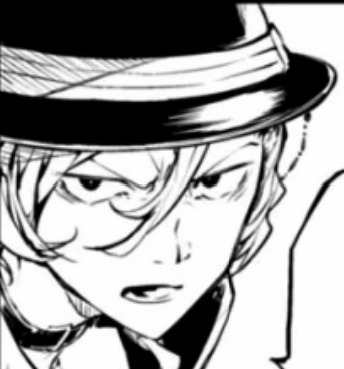

Thing is, Chuuya has always been fairly ruthless. He’s a very vengeance oriented character, right down to his fighting style (rebounding attacks and bullets). Hurt him or someone he cares about and he hurts back - and that threat will be destroyed. Parallel to this is how he is seemingly unable to turn his back on people who have helped him. Help him and he will remain loyal and protective even if that person goes on to stab him in the back. He has a very “give and take” mentality. Chuuya operates on the reciprocity principle.
So, about Q, here’s the thing: Q is a part of the Mafia, that's true. But Q has never helped them, only hurt indiscriminately. Mafia philosophy says “protect your own and follow the boss' wishes no matter what”. But Chuuya’s philosophy is saying “neutralize the threat”. And interestingly, Chuuya’s philosophy won here. If Dazai had've killed Q, Chuuya would’ve defied Mori’s orders in favour of his own judgement, which is extra intriguing because it emphasizes Chuuya’s loyalty to the people within the Mafia, not the Mafia as an organization itself. This is in full contrast to people like Tachihara and Hirotsu, who prioritize the organization and orders above all.
And about Q being a child: I don’t think this is such a big change in his character if I'm being honest. Chuuya knows full well how dangerous a child can be - he was that dangerous child. People underestimated him as a teenager and paid for it dearly; do you really think he'd make that same mistake? He also has a very warped view on the responsibilities and ways a child should be treated… while I do believe he probably is protective of those younger than him, he also equally understands that a child can be just as much of a threat as anyone else. For Chuuya, it’s always a matter of what wins out: the person or the threat? In this case, it was the latter.
The thing is, it's interesting the way they react when you look at the way Q eerily parallels aspects of their younger selves - as well as some things that carry over to the present.
Dazai and Q share central themes of control.
Q's mind control ability is actually referenced by Dazai as being essentially the worst kind of ability there is, and I know I've mentioned before how he seems to react poorly to those people who attempt to mentally control others, placing them on a heightened level of danger (think Fyodor, Mori). I don't think I need to get into Dazai's control freak tendencies - and what's more, after Q's introduction, after he says that mind control is the worst kind of ability there is - he ramps up his masterminding and enacts as much control as he can over the proceedings of the events that follow. Q's ability is interesting in the sense that it allows them control over others, implying Q came from a background of little control. I have also hypothesized that Dazai, with his need for situational control, similarly came from a background of little control. It's also likely they both were hurt by others - Q's ability turns any pain inflicted on them back around, giving them a way to fight back, while Dazai can level the playing field of any unfair advantages by nullifying abilities.
Q's small segment in Fifteen is also interesting: they're near completely zoned out, just staring off into the distance without responding to their environment until Dazai gets directly in their face. Then Q suddenly flips a switch and becomes all cheerful and playful. It reminds me of young Dazai's quick switches between faux cheerfulness and emptiness earlier in that same book.
They also both have quite interesting relations to pain. Q wonders why cruel things always hurt them, but Q makes this a foregone conclusion by purposely arranging others to hurt them so they have an excuse to hurt those people back. Q's pain becomes a self-fulfilling prophecy: they hate it, but the only means of control they know in interactions with others requires it. Dazai similarly hates pain - his pain loop, however, is more emotional than physical. Dazai feels isolated and alienated from others, but his attempts to exert control require him to distance himself and rely on his mind over all else. He also leans into his inhuman side when it becomes apparent pain is unavoidable (I think often of his reactions throughout Dark Era to Ango's betrayal) - again, this becomes a self-fulfilling prophecy. He will not find anything. He will continue to be separate from humanity if this cycle continues. That was why it was imperative that Odasaku break him out of it. Self-sabotage behaviours and unhealthy cycles, physical and emotional, are apparent with these two.
For bonus points: both have injured right arms.


On a more superficial level too, Q and Dazai both have "creepy child" energy, with emphasis on the child part - they are both legitimately disturbing at times but also have moments where they show childlike interest and behaviour. (I encourage people to check out Q's mayoi cards for this - I know it's not super canon or anything but it emphasizes their "kiddishness".)
Also I'm unsure if this is significant, but there's this detail too:


Q has a very unusual right eye with a star in the center. The right eye is also the one Dazai kept covered in the Mafia. Notably also, Q's right eye is frequently obscured by their hair in key scenes.


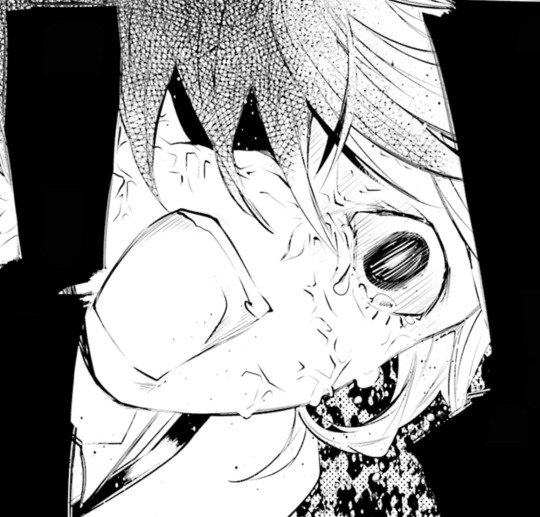
...Does it mean something? I have no idea. But it's potentially interesting so I thought I'd add it.
Meanwhile, Chuuya and Q share themes of loss of control.
For Q, this is quite obvious. They are literally locked up; imprisoned within the Mafia and unable to exert control over their circumstances. For Chuuya, it's a little more subtle but still present, I believe: I invite people to look at his character song and mayoi (particularly aquarium) for direct references to feelings of being trapped. However, looking at Fifteen and Stormbringer, there are a few mentions of freedom that are intriguing in relation to Chuuya's character. In Fifteen, both Dazai and Shirase mention Chuuya's "freedom"... but this is almost a mockery of what's really going on. A party to celebrate Chuuya's freedom is really an elaborate set up for a trap. Shirase telling Chuuya that he should have the freedom to act on his own wishes is really a cover up for a betrayal. In both instances, Chuuya's freedom is a lie. Stormbringer, at the very least, instates a sense of agency where he at least has the freedom to make choices about his own actions - that's the whole point of his hat; it's a symbol of autonomy (also anti-mind control; more on that in a bit). However, Stormbringer also systematically strips away the start of any alternate path Chuuya could've taken - he cannot be the child he was, he never got to hear the pitch on living in the light. He feels genuine gratitude towards those in the Mafia - they have his back, which is more than he could say before, but at the same time, the Mafia is kind of the last option available there if he wants not to be alone... and Chuuya does not want to be alone. (Seriously. His character song. Please look at it. Also Stormbringer.)
Now, onto their abilities, which also parallel in the sense that they are both used to "get back" at people. Chuuya rebounds attacks - bullets shot at him ricochet back at the people who fired, and Q hurts people who hurt them. There's a very reciprocal relation to the way they use their abilities, and it is absolutely to induce fear and intimidation in others, but there's a key difference. Namely, Chuuya fights only against enemies or people who strike first. Q, on the other hand, intentionally makes "enemies" out of even innocent bystanders just to have a reason to hurt them back. A lot of this is due to Q's misanthropic nature - I doubt Q has ever had a positive bond with another person, and so Q sees the whole world as their enemy - a world which, to them, does not want them in it. Chuuya, on the other hand, has had people who care about him, and he cares about them in turn. He's a bit jaded but he doesn't hate humanity, far from it.
In that sense, Q parallels Verlaine in a sense, right down to being kept in a special secret room in the Mafia, hehe. Though again, there's differences. Verlaine chooses to stay in that room, first of all, while Q doesn't have a choice. Verlaine's angst is internal identity based while Q's is more external situation based. In response to their pain, Verlaine chooses to relinquish control of himself (Brutalization), and Q chooses to have everyone else lose control of themselves (Dogra Magra). Verlaine says "look at how monstrous I am and how I hate and hurt because of it" and Q says "look at how monstrous you all are and how I hate and hurt because of it".
Chuuya is not so far on either extreme that he emulates this - but he could've ended up like Verlaine, and he admits it in Stormbringer. He could've maybe ended up something like Q too, if he'd remained trapped as a lab rat. But see here's the key with Chuuya: his hat makes it so the choice to lose control of himself is his alone, and moreover, that losing control doesn't mean he goes out of control. He trusts that he can lose control for a bit, place it in someone else's hands for awhile before it goes too far. Trusts that the choice to lose himself will be followed by the keeping of a promise to bring him back to himself. Chuuya has bonds, and that's the key difference.
But uh. Going back to parallels... about the scene where Q gets tortured... and the scene where Chuuya gets tortured...


Is this significant...?


...is... is this...



...


.............
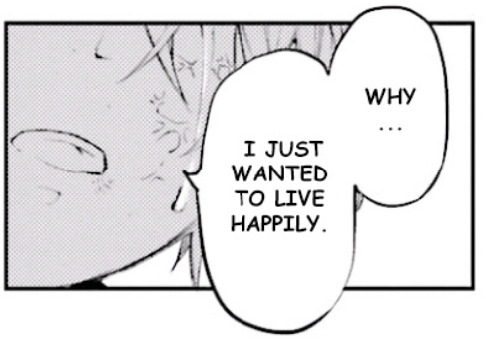




Um. I may be delusional. But. Well. *gestures at all of this*
So, where does this leave us? Well, we have Dazai, who sees a manipulative, mind-controlling kid that he calls a "walking disaster", and we have Chuuya, who sees a dangerous ability user that is too big of a potential threat to not be dealt with, so the two decide the best course of action is to kill them about it. The reason Dazai did not follow through is likely a mix of his stated reason (the Mafia cannot harm Dazai so long as he is needed to stop Q), and probably also that he isn't really supposed to be directly killing anymore.
Nice, guys. Really clear and consciously held self-concepts you got there.
Considering everything, it's maddening that all we have on the dynamic between these three is: Q joins in Fifteen at the same time as the other two and is assigned to Dazai since he can stop their ability. Mori doesn't know what it is at that point but assumes whatever it is will be manageable because Dazai can just nullify it. It... clearly wasn't.
I feel like there has to be something here and that we're going to be coming back to it. Q, the old Boss, how Mori got so close as an underground physician in such a short time... there's so much about the Mafia we don't know so I'm assuming the story will shift to focus on these points again... someday. Hopefully.
#i have even more thoughts unwritten if you can believe it but seeing as it is 4 am i should probably stop. also this is too long.#but yeah i frequently think about how horrified and genuinely spiteful dazai is with q like... what happened???#ok just had an awful thought: what if whatever happened with q inspired dazai's brutal treatment of akutagawa#...honestly maybe. it's actually a possibility if something went terribly wrong before.#this... isn't the meta i was supposed to be writing or even started to write... oh well#enjoy?#is this even coherent?#bsd#bsd meta#bsd q#bsd dazai#bsd chuuya#soukoku#skk#bsd fifteen#bsd stormbringer#storyrambles
900 notes
·
View notes
Text
Because some of you are being weird again, I just wanna go on the record and say that my dream scenario is no canon buddie this season.
Now that we have the renewal, they can take the time to develop the relationship to a romantic level without having to cram in there two coming out storylines and whatever else it'll take, when literally dying wasn't enough for these two.
I wanna see it being acknowledged this season, yes, the attraction, the feelings, but I wanna see them get there.
And just fyi you can fuck other guys before you settle down with the The One, so would you guys start acting normal about the possibility of Buck being with anyone but Eddie?
He has been in multiple relationships since they've known each other. If you think it's any different when it's a guy, boy, do I have news for you.
#don't get me wrong if buddie goes canon i'll be elated#but if not i'm still good#this isn't the buddie show anyway#i wouldn't mind some misguided kissing to make the situation more complicated for next season though but oh well#whatever happens i'll be good cuz i love this show#anyway#buddie#911#911 s7#oliver stark#ramblings#my stuff
86 notes
·
View notes
Text

Expanded on the Vash chibi collection 🤞
#mq art#If my printer can handle glossy vinyl and if I can figure out how to jailbreak it maybeeee I'll start offering stickers#since redbubble keeps taking everything down#trigun#trigun stampede#trigun 98#trigun maximum#vash#vash the stampede#tristamp#tri98#trimax#anyways slowly getting better at drawing that spikey hair#really wish i'd stop hyperfixating on characters with hair like that tho cause it's SO HARD TO DRAW#what in the eff happened to the cropping on this 🙄 oh well whatever
84 notes
·
View notes
Text


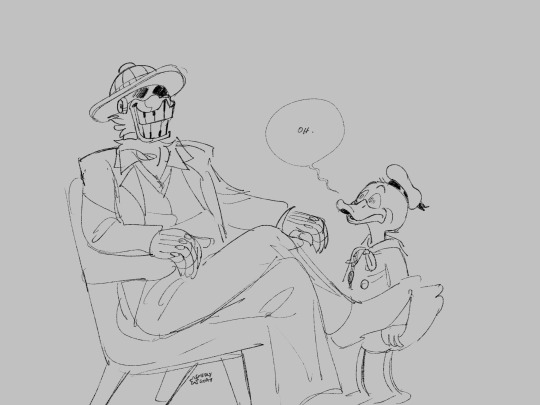
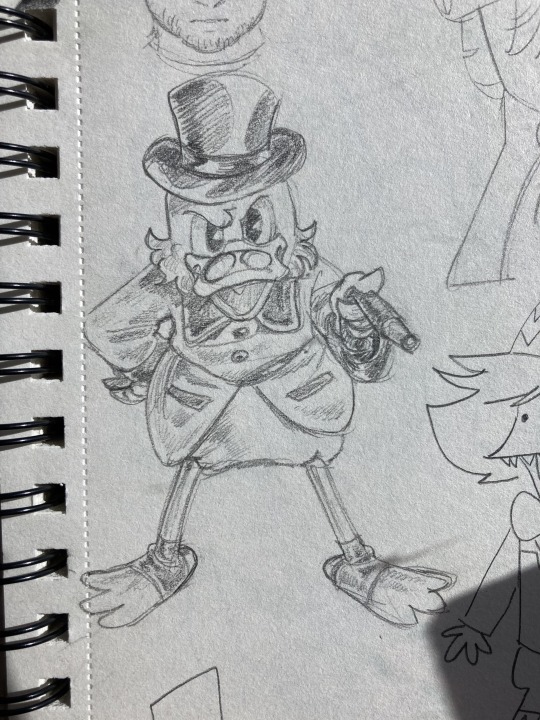
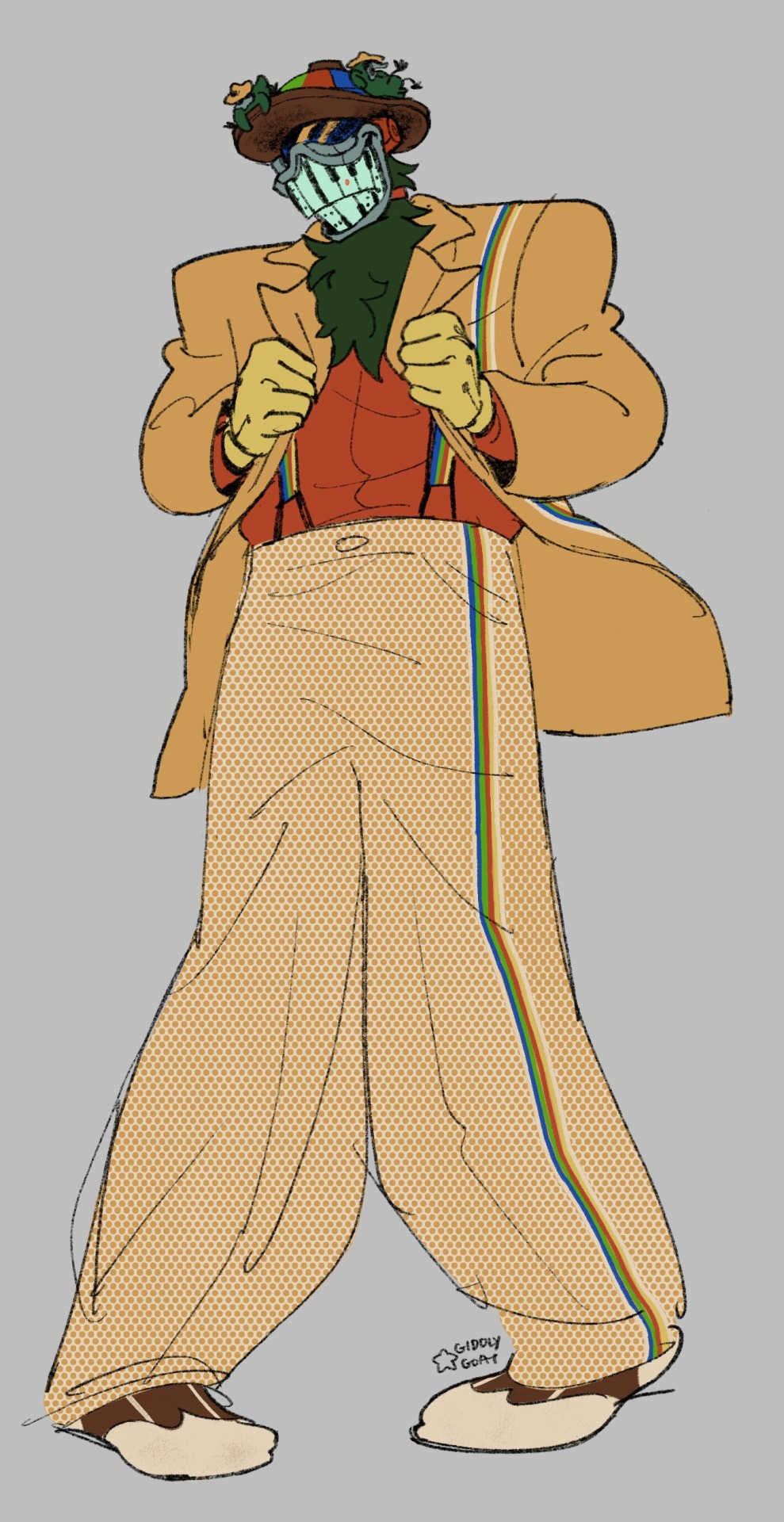
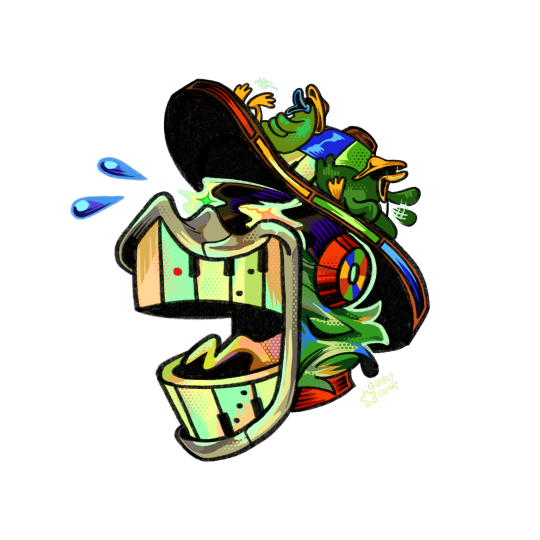

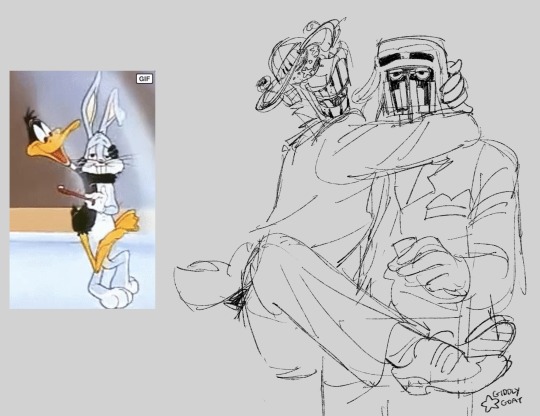
i have SO many ducks LAWL
my mind is basically a big cartoon duck / silly robot melting pot rn and i always forget to post things as i finish them so i’m putting them all together. we got some donald, high roller, scrooge, my shameless ducktales oc [thinking of naming him Oliver Branch teehee] and a silly scrawl featuring chip inspired by a giggle shared with some chums ohohoho
#[long inhale and knuckle crack] time to tag this monster of a post#donald duck#scrooge mcduck#high roller ttcc#high roller#ducktales#ducktales fanart#ttcc fanart#ttcc#toontown: corporate clash#ducktales oc#chip revvington#my oc has a serious adhd stutter btw because after a particularly porky pig-like stumble i realized i need to Embrace It + Get Sillier#uhhh did i tag everyone? i think i did#huey is There but i don’t wanna tag him for just one doodle idk#OH ALSO brace yourselves for donald x oc posting bc it very well may happen LAWL#i haven’t self shipped in like 5 years i’m so rusty but it’s rlly nice to just. Have Fun and not worry about being cringe or whatever TEEHE#giddly’s art#no id
201 notes
·
View notes
Text
thinking thoughts about things and such but I do wonder if cas had, say, an amnesia moment or whatever and dean did dean things which would include kidnapping him and keeping him in an underground bunker etc etc you understand. like if and when cas does come back to himself. i do wonder. if his freaky ass would be so into it that he'd jump dean's bones about this violation of human rights. i do wonder.
#like. I'm just saying. the OH HE WANTS ME of it all. like. OMG YOU. YOU KEPT ME NEAR YOU????#like brother he was. he had you like straight up in the dungeon brother get out#but he won't listen you know#doe is talking again#spn posting#destiel is toxic? to the world probably. but they are making it work and they're happy about it so you know. it's. whatever#btw. btw. I'm sleeping deprived again. well not exactly. I'm just sleepy. it's bc I'm sleeping all weird these days :(#I will go have lunch now. ans then I will sleep.#i am also reading this book about cardiology and it's very interesting but it's also non-fiction so it's slow going yk#anyway ask me about things I can talk sometimes!#about destiel#Castiel you little freak you you!!!#ps: dean would also be into it if it were to happen the other way around. altho i do think non-godstiel cas would not do that to him.#okay byeeeee
125 notes
·
View notes
Text


watching the miraculous movie has done irreversible damage to my brain. hands you miraculous shuake au.
#i said it before and i'll say it again. i never liked aus until these 2 came around. i really do not know how or why it happened#i see them in everyone and everything#persona 5#miraculous#miraculous ladybug#squeak squeak#idk why i drew that weird pose for goro i wanted to show off his cape but then i realized i'd have to draw his like. backside#and im not good at that. oof.#i like the akira drawing so much more Oh well#they cant all be winners#anyway the movie. i really liked it.#i watched the show often in the past and loved it but then all the weird shit happened and like#i still liked watching it even then but then my brain switched#and i couldn't fucking STAND it anymore#i genuinely hated seeing anything about it. filled me with rage. but this movie? did not.#might have to do with the fact that astruc or whatever his name is didnt influence it as far as i know#goro akechi#akira kusuru#shuake#idk if everyone can read my handwriting i wanted to actually have like the. au details on the drawings#and i dont like writing so much on my tablet.... gets a jumbled mess after a while
163 notes
·
View notes
Text
born to write fanfiction forced to go to pilates
#WHAT IS HAPPENING. HOW DID I GET HERE#THIS IS NOT MY SCENE I SHOULD NOT BE HERE OR WHATEVER THE WOMBATS SAID#no hate to pilates itself im acc very pumped for it but the entire setting of a gym TERRIFIES me#but the uni is running a bunch of shit for women’s month and one of the events is this where they’ve booked the gym#and for 3 hours for free you can just go to different sessions#and me and my mate saw ‘free’ and didn’t look back like one thing I love about us is We Will Just Try Shit#and now im here in athleisure kit. no cargos in sight#I actually can’t remember the last time my outfit was so streamlined I feel naked rn#only plus is I’ve somehow got a decent fit like I had a real moment of secondary school PE class thinking I was gonna#be looking around feeling shitty and out of place for not having The Branded Shit but somehow I’ve acquired stuff#leggings from my old flatmate who IS a gym girlie meaning im twatting about in GYMSHARK LEGGINGS LIKE SOME SORT OF POSER#I feel like im going to dance classes again this is so. this entire thing feels on the edge of nostalgic and generally just WEIRD#I feel like the Cool Girls will be there I feel like they will know there is something Fundamentally Off about me and I’ll never know what#BUT OH WELL. DO IT SCARED#hella goes to uni
49 notes
·
View notes
Note
are the songs on your playlist mostly for specific seasons/eras/moments or are they mostly more general songs for the overall character? what are your favorites and why?
in the spirit of recent events these are the songs I put on after every stream to really feel everything that happens
#old me is 10x harder thanks to what just happened#used to listen this thinking about me killing pangi but oh my god#you can connect all of these to whatever princezam moments you want to me they apply to like every aspect of the character#I'd say these are like the strongest songs in the playlist everything else is sort of just here to keep the mood similar#there's also a few more songs that only really hit when I was in like season 4 lore mode or just certain eras of lifesteal#examples being like sorry not sorry by tyler the creator for end of season 4#lowkey another life by pink pantheress is another banger but doesn't fit too well with the stuff i linked above lol#also two of those songs were given to me by bacon i know he wants credit
34 notes
·
View notes
Text
Suggestive winterkov under cut❄
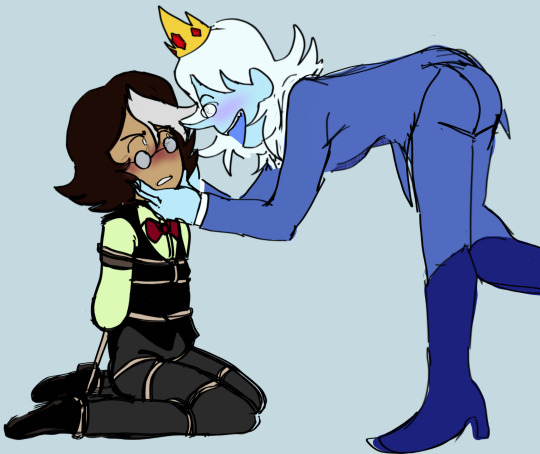

Yeah
#suggestive#winterkov#hope this makes it to rule34! make it happen!#mdni#sigh.#simoncest#i hate using that tag but nore people who want to see it will see it#hes probably saying some shit like#'oh my sweet simon of COURSE i knew you'd be into this! well no I just took an educated guess and i was right! fascinating isnt it?'#or whatever#preceded by simon being bratty like '/////how did you-'
145 notes
·
View notes
Text
transphobes who are obsessed with “genital preference” are so wild because no one is making you fuck trans people. the issue with a trans person Making you fuck them would be the issue of rape and not of transness. you are not entitled to know the details of someone’s body in advance and if at that point you change your mind consent can always be revoked, or its again not an issue of transness but of sexual assault.
if you have a preference no one is going to MAKE you date or fuck trans people but if you are super loud about your “preference” its annoying. and when you start to justify that preference by saying well i’m a lesbian or i’m a gay man so….that universalizing and making a rule out of what you say over and over again is a Personal right and preference is when you are being a transphobic piece of shit. and you are not speaking for me or for the majority of dykes and fags and all other queer people who dont abide by outdated dumbfuck bioessentialist ideas
#its so fucking annoying. they invent this strawman of trans people who are MAKING YOU GET WITH THEM!!!!!!!#as if that happens. so fucking frustrating#plus. trans people do not want you. you are like the girls in the locker room who think that a lesbian is gonna perv on them. thats the same#exact shit. and i assure you you are Not worth it#whatever. trans girls are so beloved and belusted by dykes including me. hope that helps#ask to tag#kora.txt#im writing this quickly based on personal thoughts i hope it doesnt like. blow up. but if it does oh well
257 notes
·
View notes
Text
A Timeline of Events in the Artemis Fowl Series

If anyone's interested, I did do an actual analysis for where I pulled some of these dates from. But because I cannot type succinctly to save my life, it's 5,000 words long, so that's below the cut. I also put the timeline there again, but in three separate images, so hopefully they load well enough to be fully legible if the above isn't.
A thousand thanks to @sadbitchapologist and @zahnie for their help and advice with this, despite neither of them having any more than the barest interest in the series and therefore having no clue what I was on about. Thanks also to @orangerosebush for fielding completely out-of-the-blue questions about the French school system, so I didn't have to attempt to navigate web search results to figure out what mandatory gym classes were like for the sole purpose of plotting Luc's birthday on here.
An Analysis of the Timelines in the Artemis Fowl Series
A Brief Introduction
The Artemis Fowl series is made up of eight books covering a range of years and events. I wanted to see how accurate the timelines present in the books were, as well as try and plot out some other details implied in the novels but not explicitly stated, to have a better understanding of the overall world-building. To that end, I went through the series and made the above timeline. I colour-coded it based on the relevance of the specific items to certain categories, namely Humans, Fairies, Villains, and the Series itself. This does mean that some things could have fit into multiple categories. For instance, you will see some items involving Opal categorized as Fairy-Specific (such as her college years, as those are fairly neutral to the main plot or her villainy), Villain-Specific (such as her setting up her emergency fund, as that is mostly related to her schemes as opposed to relevant to her existence as a fairy, or part of the main plot of the series), and Plot-Specific (such as her opening the Berserker Gate, the primary plot point for the final book).
Before we really delve into things though, we should establish the baseline assumptions I was working with. Firstly, I am only using the original series. I have not used anything written in The Fowl Twins trilogy, given that those books seem to ret-con a considerable amount of the original information, and that is far too many headaches to give myself. Any supplemental series information, such as the short stories found in The Artemis Fowl Files, or anything from interviews is also not included. The premise here is: using just the original books, what is the event timeline of the world? The second thing we need to establish is that I am using the North American releases of the novels. I did make notes on where each bit of information comes from, but there isn’t really a citation style for this kind of thing, so I’m not sure how relevant that is. The third assumption is that the first book takes place the year it was originally published. According to my copy, the original publication was 2001, with the first American paperback edition coming out in 2002, and the first mass market paperback being released in 2003. This means our starting point is in 2001.
For sake of clarity, this analysis will start with setting the dates of the books and continue on from there.
The Basics of The Books
With that out of the way, let’s talk about the first book, Artemis Fowl (AF). It is actually not until the very end of the book that we get a solid answer for when it takes place. It’s only in the last few pages of the novel that Angeline Fowl leaves her attic room after all the plot points are tied up and announces that it is Christmas Day. This might be cause for concern – Angeline had not previously been established as a particularly reliable narrator – but given that we are asked to believe that Holly’s ‘feel better’ mood booster worked, and that neither Butler nor Artemis balk at or question the pronouncement that is Christmas Day, we’ll accept that it’s true and move on. This means that, with Butler’s earlier announcement that he was stuck doing four months of stakeout, we can say with a fair amount of certainty that Artemis obtained and translated the Fairy Book in September 2001, and managed to capture a fairy in December of the same year.
Moving on to Artemis Fowl: The Arctic Incident (TAI), we are given a decent chunk of information, albeit spread out a bit. The first is the announcement that the ransom drop for Artemis Fowl I is to be held on the fourteenth. The fourteenth of what, you might ask? Well, we are told that Artemis is currently thirteen years old. Clearly, things are past September 1, 2002 (we know Artemis’s birthday is September 1 based on information in both the fifth and seventh books). We are also told that Luc Carrere has been trading with the goblins for six months, starting in July. That puts us in either December or January, but we can narrow it down further since Artemis gives us another helpful clue. He mentions they are not expecting to see the dawn while attempting to rescue his father in the Arctic. There are only a few latitudes on Earth where polar night (of any type) occurs, and at Murmansk, polar twilight occurs between December 10 – January 2. Combining all of this, we learn that TAI takes place December 14, 2002, give or take a few days to either side.
This can be corroborated by information in Book 3, Artemis Fowl: The Eternity Code (TEC). After Holly heals Artemis Senior, we are told that it takes over two months for him to wake up. Since we are specifically told two months, as opposed to two and a half or three, we can conclude that the events of TEC take place in March 2003. Mulch gives us some information that confirms this. He was living in LA “less than four months ago,” and since he was conscripted to help with the events of TAI in December, a March plotline fits the bill. We are given further confirmation as well: Spiro mentions that Artemis will be fourteen in six months. A specific date for Artemis & Co.’s attack on Spiro’s Needle can be pulled from the throw-away line that Pex and Chips are “burying” Mulch on the full moon. A quick web search tells us that the full moon in March of 2003 takes place on March 14, and the rest of the events in the novel take place roughly two days to either side of that.
In Artemis Fowl: The Opal Deception (TOD), the fourth book in the series, we are given several very clear indications of when the events take place. Firstly, Artemis is contemplating that at fourteen years and three months old, he is the youngest person to successfully obtain The Fairy Thief. Based on previously noted details that his birthday is in September, the events of TOD must take place in December of 2003. Additionally, we are told that things are the middle of winter and Opal has been in a coma for eleven months and counting as of the end of TAI, another December plot.
Artemis Fowl: The Lost Colony (TLC) requires the most math and interpretation so far to figure out when it takes place. We know Artemis is still fourteen, so the main events clearly happen sometime between January 2004 and September 2004. Beyond that, we are using a fair amount of context clues. Artemis and Butler have evidently been traveling for four months looking for demons, so we are dealing with events in at least May. But that still leaves us several summertime months to work with, so to establish a timeline here, we will need to look forward a bit. In the sixth book, Artemis Fowl: The Time Paradox (TTP), it’s noted that Artemis is not yet fifteen, and has, on multiple occasions, spent the full moon in the study. Ergo, he’s spent at least a few months back from Hybras. If he has been back for two months and not yet turned fifteen, he would have had to have returned by July at the latest, and since he returns almost three years later than he leaves, we are looking at him returning in either May or June. This would have him disappearing to Hybras – and by extension, dealing with the earlier events in the book – in June, July, or August. After his conversation with Minerva, he notes to Butler that they “are planning a June wedding,” which wouldn’t make sense to say if they were currently in the month of June. From all of this, we can extrapolate that the first three-quarters of TLC take place in late July or early August 2004, with the triumphant return of our intrepid heroes occurring in June 2007.
As previously stated, TTP mentions that Artemis is still not fifteen, but is nearly there. He has also been home again for at least two months. This would put the events of the sixth book in August 2007. At least, the events set in the current time period. TTP does bring back time travel, and with it some problems. We are told that Artemis and Holly jump back nearly eight years to Artemis being ten and trying to fund searches for his missing father. This would put the events of the past in early 2000. However, other details presented regarding Artemis Senior’s disappearance, which we will discuss later, make that impossible. Artemis also admits, in TEC, that he was eleven when his father disappeared, not ten. If we take a bit of creative license with our interpretations and base the time-jump to the past on other presented information as opposed to the dates given in TTP, we can say that Holly and Artemis instead return to early 2001. This lines up with further details, such as the sinking of the Fowl Star (as calculated a few paragraphs down in this analysis) occurring in December of 2000, and the textual confirmation in TTP that it’s barely two months past that sinking when Artemis brokers the deal(s) regarding the silky sifaka lemur. Since, at the end of the day, the time jump impacts very little in the grand scheme of things, and the year 2001 actually fits in better with other textual evidence and events, that’s what I’m going with for this timeline.
The seventh book, Artemis Fowl: The Atlantis Complex (TAC) gives us a very helpful base point! It takes place on Artemis’s fifteenth birthday, September 1. From our previous results on setting dates for book events, that would be September 1, 2007. The sections in which Butler and Juliet are fighting mesmerized wrestling fans and meeting up with Mulch are noted in the novel as happening “the day before,” which would fall on August 31, 2007.
Artemis Fowl: The Last Guardian (TLG), the eighth and final book in the series, creates some problems. If we assume that Artemis starts receiving treatment for his Atlantis Complex immediately after diagnosis in TAC¸ that would put him receiving treatment in September 2007. We are told he is certified as cured after six months. Yet we are also told that the rest of the events of the book take place in the week or so leading up to the Christmas holidays. Everything so far has said that the Artemis Fowl series follows the current calendar, in which case there is no way that six months can fit between September 1, 2007 and December 25, 2007. However, the only reference to Christmas is in two lines noting that the Fowl parents were planning on holidaying with their children on a foreign beach. If we simply say that six months have passed, and they are instead planning on spending the Irish school system’s spring holidays in the French Riviera, everything else lines up much better. So that’s what I’ve done. This would also put the resurrection of Artemis, after the events of the book and a further six months have passed, at roughly September of 2008. There is a pleasing symmetry to Artemis being born and then re-born in September, though if you want to get really technical and say the events of TLG take place during the 2008 March full moon as Opal claims (as noted in another web search as March 28), a six-month wait time for the clone to grow would put the resurrection in October. Still, there is something to be said for having a boy’s ghost haunting a clone of himself close to All Hallows. Since it’s the last plot point of the series, you can choose which you’d like; it doesn’t have to lead to anything else after it.
Let’s Talk Timelines: The Beginning of the Line to The End of The 19th Century
Now that we have our baseline book time periods established, we can get into the math used to determine some of the events in the timeline above. Several events are easy; we are given specific dates for them. Turnball Root meets Leonor in 1938, Juliet wins the Miss Sugar Beet Fair beauty contest in 1999. Other things are based on some basic math, such as Artemis claiming his parents got married fourteen years prior to AF¸ putting that event in 1987.
The majority of the items on the above timeline, however, do take some mathematics, extrapolation, and interpretation to plot out. To try and keep everything organized, we’ll start at the far left of the timeline, and work our way forwards, looking at events oldest-to-newest to explain why they are where they are on the graph. I won’t be getting too in-depth on everything in the graph, since I’m not sure how relevant the notes on the very minor side characters such as Carla Frazetti are, but I’ll at least try to touch on some of the more relevant points.
To start with, the Battle of Taillte was noted in the 2000’s as being ten thousand years ago, putting that at 8000 BCE. Similarly, the last dome breach at Atlantis was apparently eight thousand years ago in the 2000’s, so that would be 6000 BCE. Troll sideshows were legal in the early middle ages, which implies they were not legal after that. A quick web search says the early middle ages ended around 1000. The first crusades were in 1096-1099, and as those crusades are the start point of the Butler-Fowl working relationship, a point for noting that comes next on the graph.
From there, we get into more modern – relatively speaking – events. Briar Cudgeon and Julius Root are noted as attending the LEP Academy together and being raised in the same tunnel, as well as having about 600 years of history together. If one assumes “being raised in the same tunnel” is similar to the human equivalent of “growing up in the same neighbourhood,” we can assume the two were born roughly 600 years ago, in the 1400’s. Vinyaya is portrayed as being of a similar age to Root, so her birth can also be put in the same general era. We are also told that Fowl Manor was originally a castle built in the fifteenth century, that in the early 2000’s the theories of timeline corruption were first introduced over five centuries ago, and that cloning has been banned for over five hundred years, so those three events are also tossed into the 1400’s.
Julius Root is noted as doing his LEP basic training 500 years ago in Ireland, so that would have to be in the 1500’s. He would have attended the Academy before then, putting that in the mid-to-late 1400’s. As previously stated, he was in the Academy with Cudgeon. Opal also met Cudgeon in college, and competed with Foaly for science prizes there, so they were all in school at the same time.
Mulch now enters the picture. We aren’t ever given a specific age range for him, but we are told about his career. He has, apparently, spent three centuries in and out of prison after a couple centuries of success as a thief. This would make him at least five hundred years old. There is a brief mention that he tried the athletic route at college before becoming a thief, so he would have to be an adult at that point, putting his age at roughly 550 years during the events of the series.
We then enter a period filled in from one-off lines throughout the series, presumably added to give some depth to the world. Things about the wine cellar at Fowl Manor being a seventeenth century addition, Captain Eusebius Fowl and his crew dying in the eighteenth century, and Mulch first faking his own death over two hundred years ago.
Time Marches On: The 20th Century
There is nothing of much relevance to linger on between the 1550’s and the 20th century, so we’ll jump ahead to the 1900’s, when we have Holly Short’s birthday. She is in her eighties during TLC, and her father died “over twenty years ago” when she was “barely sixty” as of TAI. Based on that, she would have been in her early eighties in 2002, putting her birthday sometime in the 1920’s. What a doll.
A few more birthdays now appear, and we’ll ignore, for the most part, some of the irrelevant ones. I don’t think we are at all concerned with Gaspard Paradizo’s birthday, or Mikhael Vassikin. We are, however, rather more interested in Jon Spiro, Domovoi Butler, and Artemis Fowl I.
Jon Spiro enters the series in TEC, as a middle-aged American. A quick search on the Internet says that middle age is generally noted as being between the ages of 40 to 60. We are told that Spiro has worked in three main industries over the past two and a half decades. Additionally, we are told that law enforcement has been “trying to put [him] away for thirty years.” If we assume he entered the working world at twenty, spent five years developing his professional self, and then started going down a path of questionable legality to get the police after him, that would put him at fifty-five in 2003, and born in the late 1940’s.
It was a bit easier to determine Domovoi Butler’s age, and we can get more specific with his actual birthday. We are told that he is forty at the start of TEC, and he is still forty during TOD. From that, we can assume his birthday is not between March – December, which means it has to be between January – March. Now, we can just leave things there, but contextually, Butler says in late March 2003 that “a lot of people know [him] as a forty-year old man.” Since I doubt he’s the kind of person who introduces himself by announcing that his birthday was last week, we can assume that his birthday is not in March. Since about half the books in the series take place in December, and there is never any mention of Butler’s birthday coming up soon, we can likely assume it isn’t in January. We can therefore conclude Butler was born in February, 40 years before 2003, which puts his birth year in 1963.
We then have Artemis Fowl I. This one took the most extrapolation to determine. We know he has run an ethical empire for a few years as of 2007, which coincides with his return to his family after being kidnapped by the Mafia. He apparently ran a successful criminal empire for two decades before that, though, so in 2007 he has been working for at least 25 years. Based on the interactions he had with his own son, I’ve assumed he was also taught to take over the family business from a young age. If he started working at his age of majority at 18 (as possible in the 1980’s in Ireland, based on a web search), we can assume he was born in roughly the mid 60’s.
Billy Kong, born Jonah Lee, is one to touch on. He plays a large role in TLC, during which we are given possibly the most backstory of any villain in the series. He was evidently born in the early 1970’s, and was eight years old in the early 1980’s. Mathematically, that can only lend itself to so many birth years, so it’s easy enough to put his birthdate somewhere in 1973, and his brother’s death date in 1981.
While we’re here, let’s talk about the 1980’s. A lot of things happen in the 80’s, so we’ll be here for a few paragraphs. Butler would have graduated Madam Ko’s Academy in the early ‘80s, Artemis I would have started working in his family’s business and stolen some warrior mummies (of note, the theft is only noted as being in Artemis Sr.’s “gangster days,” but if you are a young, rich criminal, you’d likely commit a wild theft in your early years as opposed to your thirties, which is why this is put in here). Additionally, in the mid 1980’s, Holly graduates the LEP Academy and her mother dies, as noted in TTP when she is contemplating missing three years of her friends lives.
Butler would have started his five-year stint in Russia with an espionage unit in the mid-to-late 80’s, and become a big brother in 1985. Juliet is noted at being four years older than Artemis in AF in 2001, and he is twelve then, making her sixteen at the time. We can extrapolate the month from TEC, wherein she is apparently eighteen when she is called regarding her brother’s apparent death. At the time, we are told what gifts she received for her birthday, implying it was fairly recent. Additionally, Artemis was only thirteen at that time, which would make Juliet five years older than Artemis. If, however, we trust that acolytes at Madam Ko’s start their training on their tenth birthday and get one chance to graduate per year, it would make sense for that one chance to be on their birthday, or within a day or two to allow for as much training time as possible. Since Juliet was in the midst of this one graduation evaluation when she gets the phone call and joins the crew for the March heist at Spiro’s Needle, she’d have to be born in March. (We can also corroborate this with some details from AF: if AF takes place in mid-September, that would be just after Artemis’s birthday, which puts the 4-year age difference back into play.)
Spelltropy begins for the People in 1987, if it appeared 20 years ago from 2007. Artemis I and Angeline Fowl would get married in 1987. They would have their first child, Artemis Fowl II, in 1989, as calculated by Artemis being twelve during the initial siege of the Manor in December 2001. Artemis II’s grandfather was noted as having been dead for over ten years at that point, and it was mentioned in TEC that Angeline married her husband before he really took over the family business, so those events would likely happen when Artemis was but a baby in 1990.
The ‘90s are a period where a lot of things are happening, but few are particularly important. Spelltropy has a cure found, Minerva Paradizo is born, Juliet begins her bodyguard training and her brother refuses to let her shave her hair. These, and other events in the 90’s, are mostly calculated by math along the lines of “Event A happened X number of years ago,” but since the 90’s was mostly a time of worldbuilding events rather than plot events, we’ll just skim over the specific details.
‘You Are Here’: The 21st Century, and Where The Storytelling Begins
Welcome to the 2000’s! The kick-off point of not only the 2000’s, but also the entire series, is the sinking of the Fowl Star. We aren’t given a specific date for this, but we are given enough information to extrapolate the date. Specifically, in September 2001, in AF, we are told Fowl Sr. has been missing for almost a year. In TAI, in December, we are told he has been missing for almost two years. That does have the potential to have the ship go down in either December or January, so we need to use a bit more details from TAI to make a final determination. Mikhael Vassikin and Kamar were told to dump Fowl’s body in the Kola if he didn’t wake up in “another year,” so they’ve been looking after him for one at that point. Fowl Sr. wakes up two weeks before the deadline, and as noted earlier, the ransom drop for him takes place December 14, after he has been awake for perhaps a week. From that, we can tell that the deadline for “another year” was mid to late December, putting the initial sinking of the Fowl Star in late 2000.
The analysis gets a bit confusing at this point, because 2001 is when future Artemis and Holly join the party via time travel, as well as having their regular selves in the timestream. Essentially, we’ve established the timeline for the events of TTP above, so we know the whole lemur fiasco takes place in March 2001. Artemis wakes up at the end of that book thinking about fairies, which ties in rather neatly to him then dragging Butler across three continents for six false alarms (with an assumed approximate 3 weeks between each jaunt) before striking metaphorical gold in Ho Chi Minh City in September. During their time-traveling, Holly also gets a chance to talk to Root, who wonders why she isn’t in Hamburg, which was noted in AF as Holly’s first major failure as a Recon officer and was nearly preceding the events of AF. The time-traveling would also mean that Opal would have had to harvest her DNA for future diabolical plans before March 2001, when her younger self travels to the future. Since it takes up to two years to grow a clone to adulthood, and her clone has to be ready in September 2003, we are a few months off in the time requirements, but really, for a practice that’s been outlawed for 500 years, I can offer a bit of leeway.
We are now well and truly in the thick of the main events of the series. Most of this will be tied into the initial assessments we made way at the beginning of this essay, where we established when each book occurs. Because of this, we aren’t going to spend time on anything plot-related. However, a brief note on Turnball Root and Artemis’s Atlantis Complex is likely in order. Artemis was, as previously stated, dealing with his return from Hybras and the after-effects of stealing magic during July and August of 2007. His Atlantis Complex, and Turnball Root’s plan to escape the Deeps prison, are in full swing in September of that year. We have a brief note in TAC during the evacuation of Atlantis, that Turnball had, a month before, spied on Artemis and noted his Atlantis Complex developing. Therefore, Artemis’s Complex likely came into play in late July or early August 2007. This is close enough to Artemis’s magic theft to make sense for the deterioration of his mental health, and enough time for Butler to have started to notice something was wrong, as he did. We can therefore assume that Atlantis Complex, at least in the case of magic-stealing humans who have a propensity for time travel and getting involved in supremely complicated and improbable plots, develops relatively quickly.
This leaves just one major discussion point from the last few books: the age of Artemis’s twin brothers, Beckett and Myles. The twins are first introduced at the very end of TLC. They are written as being two during the events of TTP, three during the events of TAC, and four during the events of TLG. Regardless of the time-traveling shenanigans of their elder brother, it is impossible for the twins to age two years in the eight months between Artemis’s return from Hybras in June 2007 and the finale of the series in March of 2008, so we need to look at what makes sense.
Myles has already potty-trained himself, and done so at fourteen months, so they must be at least that old. Their other behaviours would make sense for them to be two in TTP. Diapers are still a part of their lives, and their language and vocabulary fit what a two-year-old would have, at least in Beckett’s case. Since Artemis was surprised by their existence, it doesn’t seem likely that Angeline would have known she was pregnant, or at least not have told Artemis yet, when he went to Limbo. Ergo, they can’t be any older than two, since (one would hope) Artemis would have noticed his mother’s pregnancy if the twins were any older.
Additionally, in TLG, we know Artemis gave his brother a birthday present, so he had to have been around during the twin’s birthday at least once. With this fact, the twins cannot be born between March – June, which just leaves the question of when are the twins born?
The most logical answer is February 2005. If Angeline was early on in her pregnancy, say six weeks (which is when most women start noticing symptoms), when Artemis disappeared in July 2004, she wouldn’t necessarily have told him yet. Then, if we assume that since most twin births occur around the 35-week mark, that would math out to having the twins be born in February of 2005. Fast forward, and they would turn one in February 2006, and two in February 2007, which puts them at the correct age for the events of TTP. [One could argue, of course, that a twin pregnancy in an older woman (unfortunately, there is nothing in the series to indicate Angeline’s age) and in a woman already dealing with significant stress could result in a very premature birth, thereby voiding any of this math and leaving the whole question of the twin’s birthday unanswered. However, since I’d rather not subject the Fowl parents to the strife and misery of having one son missing and presumed dead, and their younger children in the NICU with a low survival rate, I’m working with the assumption that the pregnancy was a healthy and normal one.]
The brief comment from Juliet in TAC about the twins being three can be passed off by them being a little over two-and-a-half and Juliet not being around as she is touring in Mexico. By the time TLG takes place, in March of 2008, the twins would have had their third birthday, allowing for Artemis to give Myles his chair as a birthday present, Beckett to be old enough to no longer need diapers, and the behaviours to act more like children than infants. While this doesn’t quite allow for the repeated textual confirmations in TLG that the twins are four, we’ll go with what mathematically makes sense.
That brings us to the end of the timeline! Not everything is touched on in the timeline, and not everything in the books is plotted (we are never given enough context to know Foaly’s or Opal’s birthdates, for instance). But the main events of the Artemis Fowl series are all analyzed, mathematically or logically or textually corroborated, and plotted out, for use or ignoring as personal preference dictates.



#artemis fowl#af timeline#you have no idea how irritated I am that there is nothing - NOTHING - in the series to give ANY context#on the ages for Angeline Fowl or Arno Blunt or Damon Kronski.#i can make GUESSES but they would be entirely based on my own bias and thoughts and vibes#which is INTENSELY irritating because i have basically EVERYONE ELSE#on the timeline SOMEWHERE#oh well. i think i have most of the events of the series on there?#if i missed something i'd love it if someone could point it out so i have a complete 'map'#oh though to be clear: i did very much do this for me!#this isn't meant to like...take away anyone's headcanons or ideas or whatever#if you wanna do something that directly contradicts the above - go for it!#i am just - as my cousin put it - 'that kind of fic writer' in which i will do insane amounts of research for the smallest of details#the one i wanted this for is honestly in a fic i haven't even started#and that is in fact several ticks down the Want To Write list#but that's neither here nor there!#i now have an outline of when things happen so i can do whatever i want with it :)
225 notes
·
View notes
Text
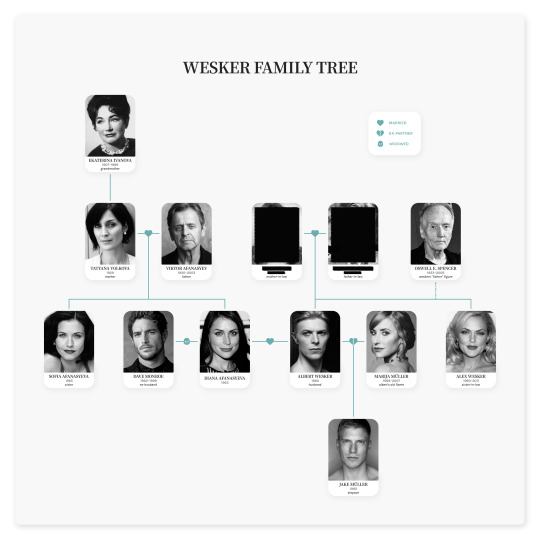
RESIDENT EVIL → THE WESKER FAMILY
To the public, little is known of the families behind some of the world’s most renowned bioterrorists, but the question remains: did they play a role in causing their children to walk down the path that they did? Or are these individuals simply ambitious criminals with delusions of grandeur?

For Diana Wesker (née Afanasyeva), her introduction into the bioweapons black market trade was upon discovering her employers were using her research into limb regeneration with salamanders to further their experiments in creating enhanced soldiers, instead of developing human therapies with which she was recruited for. Although the prospect of using biological weapons in the military did not appeal to her, the concept remained fascinating for her own selfish endeavours. Born on the 27th of October, 1963 in Sydney, Australia to Russian immigrant parents, Diana had harsh expectations placed upon her at a young age, ones that no matter how hard she tried she could never live up to. Her mother, Tatyana, was an unfeeling woman, absent for long stretches of time with little regard to how it affected her daughters, much more concerned with her craft as an accomplished opera singer. Viktor was no better. A strict man whose role as father and ballet master blurred, he pushed his girls to one day follow in his footsteps. Whilst Sofia enjoyed ballet, and went on to become a professional ballet dancer, Diana’s heart was set on going into the field of biology. She wished to make a name for herself, separate from her family – to which she succeeded.
Diana was married to former U.S. Marine, Dave Monroe, for only a year until he was declared dead in 1992 after succumbing to injuries sustained in a horrific car accident. Foul play was ruled out while Diana played the role of the grief-stricken widow, but in reality, she had snapped after years of mistreatment at her husband’s hands, and opted for something she could pass off as an accident to be free of him. For years she believed he was dead – and he was, legally – but that proved to not be the case when he found his way back into her life again in 1999. Unbeknownst to her, she had been lied to by the police and coroner, who were paid off by her employers when they took Dave’s body for themselves and used him as one of their first test subjects in developing supersoldiers. Before he could ever hurt her again, Diana’s second husband, Albert Wesker, tracked the man down, captured him and tortured him, before allowing Diana to get her violent and bloody revenge.
The origins of Albert Wesker’s involvement in bioterrorism, alongside his twin sister, Alex, are much different than that of Diana’s. The two hail from London, Canada, but unfortunately, they hold no memories of their lives there, nor what happened to their biological parents when they were eight years old. Agents of Oswell E. Spencer, an aristocratic billionaire and eugenicist, took the twins from their home and executed their parents as per Spencer’s orders. Albert and Alex were then placed in a home funded by the Spencer Foundation where they were given new names and a privileged upbringing. They had access to the best education possible, free to pursue whichever field they decided, but it was by no accident they both went into virology and bioengineering; at home, their adoptive parents – agents whom they believed to be their real parents – instilled them with the beliefs of Oswell E. Spencer, harbouring disdain for war and pestilence, and believing humans to be an evolutionary dead-end in need of a rebirth. They were only two of the hundreds of children “adopted” as part of what is known as Project W, a plan intended to develop an advanced race of human beings. The most promising candidates were headhunted by Umbrella Pharmaceuticals, the twins amongst them, where they went on to create bioweapons for the company founded by none other than the man who had handpicked them for his plan. The final stage of this was to infect the thirteen Spencer saw fit, however, only two survived; Albert received the intended effects, now possessing superhuman abilities, however, Alex was only offered more time to live due to her terminal degenerative illness.
In the summer of 1995, Diana was working undercover within Umbrella to gather development data on their projects for her company. Here, she had a chance encounter with Albert, an intelligence officer at the time, which permanently altered the course of her life. The two were never seen far from one another’s side, marrying in 1998, and they went on to become notorious in the bioweapons industry. The development of the Uroboros virus was where things took a turn for the worst. Although Diana’s infection was successful and she bore abilities that rivalled her husband’s, the plan itself did not succeed as they had hoped, and almost cost Albert his life at the hands of his former subordinates.
Now, they work within the shadows, with Diana declared missing and Albert believed to be dead. Their legacy, however, lives on with the mark they left on the world. As visionaries in their field, they influenced bioterror attacks carried out by countless individuals and organisations. In turn, they also inspired others to fight against such atrocities. One such person happens to be Albert’s son from a former relationship, Jake Müller, whose existence he was unaware of.

#mine.#oc: diana#pair: ewskers#click for better quality cause it's large & tumblr ate it ♡#hii so happy birthday diana !! queen is 60 today :]#um. there's no template cause i made this from scratch...i couldn't find any i was vibing with so i was like you know what lmaoo#i'm sorry for the essay...it was meant to be just a short rundown of the family but well...that happened. typical leah fashion...#oh and guys. did you know that there's a limit to the amount you can put in one blockquote? that's why the rest is just left like that caus#i didn't like how it looked with a blockquote each paragraph...cause the spaces between were unever. you understand 😔#with the tree i was also going to include weskids adoptive parents but i couldn't figure out how to arrange it all & make it look nice !!#cause i also wanted to have spencer in there as well cause he's a big reason why the weskids are the way they are...was maybe gonna include#sherry as well. like connected to jake (hehe) and then do her parents too but that would've made things so wide & it's already big enough#yes. i hc that albert & alex are biological twins. just for clarification there :] i don't think i added anything else that isn't canon or#implied with canon. cause the weskids were put in homes (or at least whatever ''controlled environments'' means) where they were monitored#by umbrella but were unaware of it. so yeah. i don't think i really changed much there !!#honestly i could've kept rambling cause there's alex's whole situation. there's my lore with jake's mum. there's way more with the ewskers#but it's already so long & i can't be concise so there's that lmaoo oh also diana's grandma. so much stuff#also meant to say the weskids birthday in that ramble. it's january 15 1960 :] they are capricorn sun leo moons but alex was born earlier s#their rising signs are albert is a scorpio rising & alex is a libra rising !!#had to redo the image cause typo on diana's birth year for some reason lmao so if that messed up the formatting i will sob
53 notes
·
View notes
Text

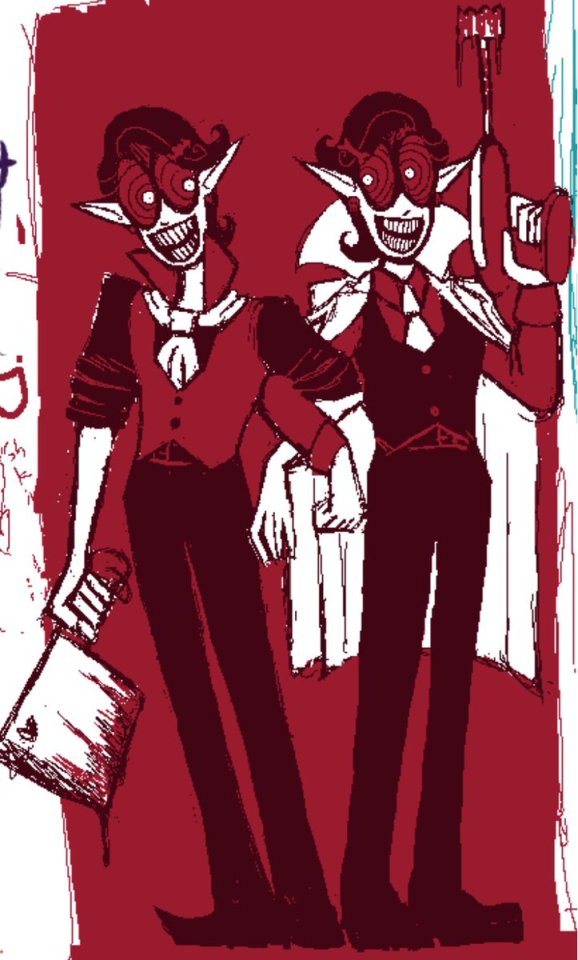
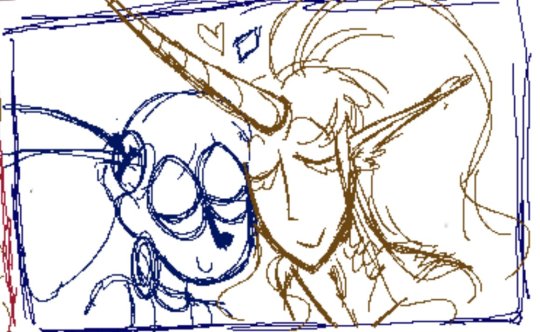

adventures from a rly fun magma i got to relaxe in today
#jrwi fanart#this gets ONE (one) proper tag bc im actually rly proud o these. thats IT!!!!#anyway AAA okay so. some1 in the magma reccomended i draw edynXkira. n im like OH MY GOD. thats GENIUS#they both work at the same job or watever. coworkers. they meet only bc edyn happens to break down infront of kira#i mean she IS under alot o stress. w knowing her brother is out there in harms way. aching not only from the decades of abuse but also#from her blatant absence and silence. she KNOWS her brother cares for her bc she feels the same way. and worries just as much.#anyway kira feels bad for whatever shes got going on w this brother of hers. whoever that is. and gets her icecream.#thats what happens in MY beautiful heart. i looove kira i loooove her shes so cuuuute and so sweeeet#IN OTHER NEWS. i also love vex n viv their canon outfits are SOOO FUN. evojelly u legend#no one knows how long i fought w those hands. oh my god. drwaing hands and tools and holding and things is so ANNOOYYIINNGG#yknow what ISnt annoying tho. drawing william wisp. he comes so naturaly to my hand now. i love him so much...#ouuuhhh prime defenders oouuuhhh i miisss youuuu hope ur doing well prime defenderrrsss#aauubabbab i think thats all i got in the ol brain. here. eat my scribbles and arts. hauve fun
23 notes
·
View notes
Text
this all being said about the light dragon and how it is definitely the biggest highlight of totk (for me at least), i Do think a lot of the reaction to it Is dependent on botw and zelda's characterisation from that game... a lot of which is kind of lacking in totk because of her more passive role (e.g. you are told about her + see her actions after they have already happened)
like. if you didn't already really like zelda and were sold on her relationship with link (and not even just from a shipping zelink perspective, like. just UNDERSTANDING they have a strong bond from everything they've gone through together) then i'm not sure if any of that stuff in totk would've hit as hard as it did. the game does very little to build on what we already know about them, which i think is both a letdown to new players (which. i am not sure why they are playing the sequel before botw, but that is how totk acts most of the time lmao) and returning ones, and as time goes on it's become harder for me to blame people for not caring for it as much.
what a truly odd game
#which also makes it bizarre that totk treats itself like its Not a sequel. even though it is at the same time#ugh the names are escaping me but i am pretty sure this is a thing thats happened in other Sequel games too#just acting like the first one never happened or only when its convenient. stuff like that#i would loveeee to know how bad covid hit totks plot development or whatever. if anything. else they may have been planning#theyve gone on record saying that apparently the plan was for zelda to Always have turned into a dragon#and assumedly the beginning/ending parallel as well (eg hands and link catching her)#but i have to assume or at least HOPE that the buildup may have been stronger. idk man its so strange truly#ANYWAY SORRY FOR RAMBLING but i do find this discussion intriguing. and i LIKED totk even despite my criticisms#its genuinely some of the most fun ive had in a video game ever and creating content for it and talking about it has made me very happy#this being said. there are some choices that were made and i do not and likely will not ever understand them#because they said nah we're done now. bye <3#like oh okay. thank you aonuma. can i at least have wind waker on switch now please#personal.txt
20 notes
·
View notes
Text
Vegetta heard that some members of the server are scared of him and he was like "Why? I'm not even a tryhard, I was the last person to get slime armor" and I'm like... Vegetta people are already scared of you, WHY would you respond to that with "But this isn't even 1% of my true power''
#i talk#qsmp talk#Vegetta be like ''This isn't even my final form''#Vegetta be like ''well if you're going to be scared of me at least let me give you a good reason for it /pos'' lmao#It's always so baffling to me (as a KarmaIand fan) seeing how Vegetta's depicted in Fool/igetta fanworks#because the way people often depict Foolish as this incredibly powerful demigod (only sometimes incorporating his actual personality / lore#is how people depicted Vegetta (minus the ''we're disregarding his personality'' part that sometimes happens) in Karmaland#Like it's almost a perfect reverse uno in terms of how people depict Vegetta in KarmaIand vs Q.S.M.P#I'm not mad about it or anything I'm just genuinely amused by how people manage to underestimate him and STILL are afraid of him#like oh honey....... whatever Foolish's ties to immortality and godhood are pale in comparison to Vegetta's#(This is nothing against Foolish BTW his lore on the previous server was fun and I'm bitter we never got to see more of it)#(The entire death totem thing was sick and also the concept of totem gods is so interesting)#The way Vegetta is depicted in Karmaland is very strange#he seems like a being (not necessarily a god but definitely something powerful)#who made their world then stepped back so he could be a part of it#So even though he respects the guidance of elders like Merlon#(to some degree)#and talks about the ''gods'' (admins) as higher powers#the world still bows to him#and that includes the QSMP world#realistically we know this is because every single admin adores Vegetta and grew up with him#but we're looking at this through a lore lense#I can get into this more later - I feel like I should elaborate on my thoughts here and add some canon backing to explain myself a bit more#but you get the jist#Me: let's post a silly little thought about the minecraft series I'm watching#Also me: LET ME CITE MY SOURCES -#Listen man you can't unlearn some things#I'm a professional writer it's in my nature
95 notes
·
View notes